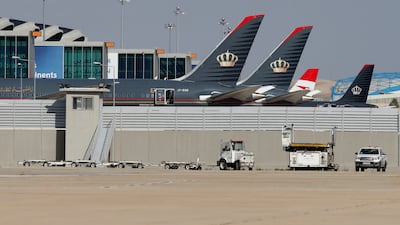Royal Jordanian plans to nearly double the number of aircraft in its fleet and add new routes in the Middle East over the next five years as the carrier banks on air travel recovering from the Covid-19 pandemic, its chief executive said.
The Amman-based airline plans to increase its fleet to as many as 45 planes, from 24 currently, as it looks to serve millions of people in the Levant region, Mr Majali told The National on the sidelines of the International Air Transport Association's annual general meeting in Boston. It also plans to operate between 30 and 40 new routes, up from 39 currently.
Royal Jordanian will also hire between 40 and 50 per cent more cabin crew, pilots and maintenance staff as operations grow over the next five years, he said.
"We're repositioning ourselves to be the carrier of the Levant, as we did 20 years ago," Mr Majali said. "The size of the airline is small but the brand is very strong."
The chief executive took charge in April for the second time in 20 years and began setting the carrier's course for recovery from the Covid-19 pandemic.
As part of its five-year growth plan, the airline is considering leasing the Airbus A320 Neos or 737 Max for its narrow-body requirements, and the Airbus A220 or Embraer E2 for regional planes, Mr Majali said.
It is also looking to add more wide-body Boeing 787 Dreamliners to its fleet, he said.
Royal Jordanian is issuing a request for proposals to lessors this week, Mr Majali said. Its fleet is comprised of 787s, A320s, A321s, A319s and Embraer E195 and E175.
The airlines plans to use these jets to serve new routes, mainly in the Middle East, and to increase existing flight frequencies, Mr Majali said.
New destinations include Alexandria in Egypt and northern cities in Saudi Arabia such as Tabuk, while adding more frequencies to its service in Iraq, to Erbil and Suleimaniyah.
Globally, Royal Jordanian aims to serve Washington, more points in Europe and resume flights to the Far East.
The airlines is also in talks to obtain permission from the US to allow it to fly to Damascus in Syria, which is under sanctions, Mr Majali said. Syria is a lucrative market for the carrier and a decision from the US is possible by the end of the year, he said.
To pursue its growth plans, Royal Jordanian plans to raise between $150 million and $200m in bank loans to reinvest in the business, he said.
It will tap into the market when it reverses its equity loss of 200m Jordanian dinars ($282m) and is in talks with its government shareholder for non-cash support, including in the form of granting assets, which it expects to get within the "next few months", Mr Majali said.
The majority government-owned airline expects to halve its annual loss in 2021 to between 70m and 80m dinars, down from an annual loss of 160m dinars in 2020, as it expects a recovery in air passenger traffic, he said.
While business travel will probably remain subdued as people rely on video-conferencing technology, other segments such as visiting friends and relatives and leisure travel will pick up faster, Mr Majali said.
Royal Jordanian expects to carry 1.5 million to 2 million passengers this year, compared to 3 million passengers in 2019 before the pandemic. The airlines has restored about 70 to 80 per cent of its pre-crisis capacity levels, he said.
The airline projects it will continue to record an annual loss in 2021 and 2022, before reaching break-even in 2023, Mr Majali said.
Royal Jordanian has tested the Iata Travel Pass and plans to introduce the Covid-19 health application across its network by November, he said.
Rising oil prices, which reached $77.7 a barrel on Sunday, is a "big concern", Mr Majali said.
A price of about $60 a barrel would be more viable, benefitting airlines and oil-producing nations, he said.
Royal Jordanian has pledged to become carbon-neutral by 2050 through use of more sustainable aviation fuel, operating more efficient planes as it renews its fleet, and use of carbon credits, Mr Majali said.
The airline halted its operations in March 2020 because of government restrictions aimed at curbing the virus, before resuming limited flights in the fourth quarter.
The airline faced a monthly cash burn of 16m dinars as it paid salaries and aircraft lessors, Mr Majali said.
In response, it renegotiated its aircraft leasing contracts and offered employees voluntary redundancies.
About 500 employees opted to leave the company, resulting in a smaller workforce of 3,300 people, he said.
By April 2021, the airline removed its aircraft from storage and gradually restored flights, first to the Middle East and the US, then to Europe in the summer.


